*Beretta 92F (M9) Service Pistol*
By: Shooter
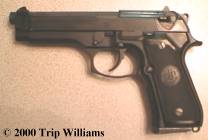
For most of the 20th century, the service pistol of the US Armed Forces was the Colt
1911 .45ACP. It served admirably throughout WWI, WWII, Korea, Vietnam and a host of
smaller conflicts. However, in the late 1970s, increasing pressure from NATO countries
to standardize on the 9MM Parabellum (9x19), and the fact that 1911 inventories were
worn out, saw the US military searching for a modern day replacement for the old war
horse.
Some of the requirements for the new service pistol included that it be chambered for
the 9MM Parabellum; be double action for the first shot and single action for the
following shots; be equipped with a hammer drop safety and hold 15 rounds in its
magazine. The new pistol also had to be manufactured in the USA.
Several companies submitted entries for the field trials, including Smith and Wesson,
Sig Sauer, Heckler and Koch, Colt and Beretta. The foreign manufacturers had agreed to
build manufacturing facilities in the USA, should their entry be selected. The trials
lasted for over a year and in the end, the Beretta 92F (M9) was chosen. Smith and
Wesson and Sig Sauer both contested this decision, but in the end, Beretta remained
the victor. A side benefit from this was increased sales to the law enforcement
community. As a side note, subsequent purchases of Sig Sauer P228s (M11) for Army CID
use have been made.
The Beretta 92F borrows heavily from the Walther P38 design. This is evident in its
open slide design, its double action trigger group, its use of a locking block
assembly and its hammer drop safety. Because of its open slide design, the Beretta has
earned a reputation for being very reliable. It also has an extremely fast lock time,
which permits very fast follow up shots. Unfortunately, due to its lack of a barrel
bushing, which is normally used to provide a solid lockup for the front of the barrel,
the Beretta 92F can be stubborn in the accuracy department. However, due to the
generous allowances for acceptable combat accuracy by the US military (groups of
5-inches @ 25 yards), the Beretta is deemed combat worthy, with most examples turning
in sub 3-inch groups.
The Beretta 92F operates from a locked breech, with the locking block under the barrel
mating with recesses machined into the sides of the slide. This leaves, what some
feel, is an unacceptably small amount of metal in this critical area. Several slide
failures have occurred. Most have been attributed to excessive use of high-pressure
ammunition, far in excess of what the Beretta 92F was designed to handle. This design
‘flaw’ has been corrected in all current models. Improved models bear the 92FS
designation.
The Army’s marksmanship unit (AMU) has gone to great lengths to accurize the Beretta
92F (M9) and has managed a high degree of success in doing so. Some of their
improvements have even been incorporated in some of the latest variations of the
Beretta 92FS, namely a front bushing to improve lockup and tighten groups.
One of the big selling points of the Beretta design is its ease of disassembly. After
determining that the pistol is EMPTY, remove the magazine and allow the slide to go
forward. DEPRESS the takedown button on the right side of the frame and at the SAME
TIME, rotate the takedown latch on the left side. This will allow the slide to move
forward off the frame. Holding the slide assembly UPSIDE DOWN, compress the recoil
spring guide assembly, located beneath the barrel, and remove. Be CAREFUL, as this
assembly is under spring pressure! Slide the barrel down, releasing the locking block,
and out. Reassemble in reverse order.
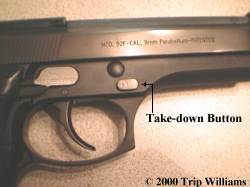
(DEPRESS the takedown button on the right side of the frame)
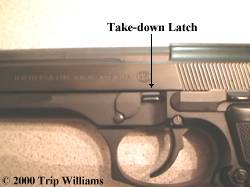
(rotate the takedown latch on the left side)
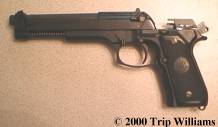
(This will allow the slide to move forward off the frame)

(Holding the slide assembly UPSIDE DOWN, compress the recoil spring guide assembly CAREFULLY)
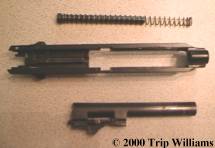
(Slide the barrel down and out)
Other members of the Beretta family include the 92FM and 92C, both compact
versions, and the 96, chambered for the .40S&W. There is even a single action version,
capable of being carried ‘cocked and locked’, a la Colt 1911. It is intended for
IPSC-style shooting. Most models are also available as DAO (double action only) or
with decockers instead of the traditional safeties. For the subgun enthusiast, there
is the 93, in 9MM, which is a select fire version, complete with folding stock,
20-round magazine and 3-shot burst capability.
The Beretta 92F has gone on to carve its own niche in American military and law
enforcement history as a reliable pistol, much to the dismay of diehard 1911 fans.
Shooter
 Send Warlord E-mail.
Send Warlord E-mail.
Address: 
All materials at this site not otherwise credited are Copyright © 1996, 1997, 1998, 1999, 2000 Trip Williams. All rights reserved. May be reproduced for personal use only. Use of any material contained herein is subject to stated terms or written permission.







